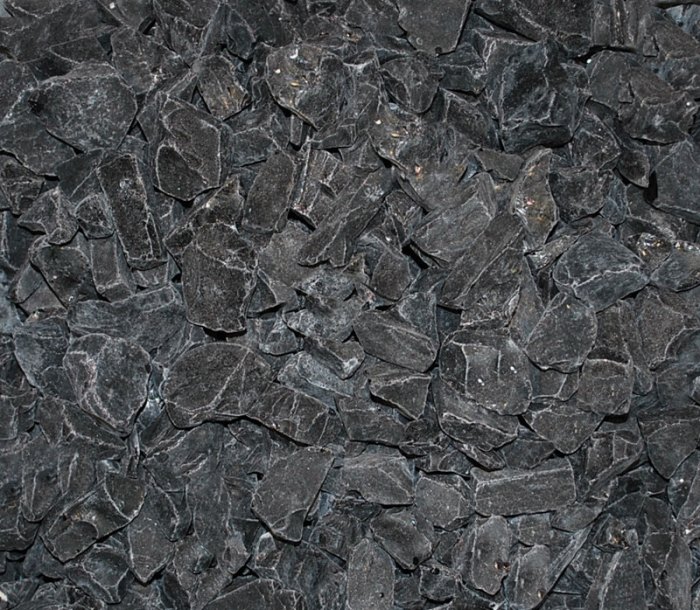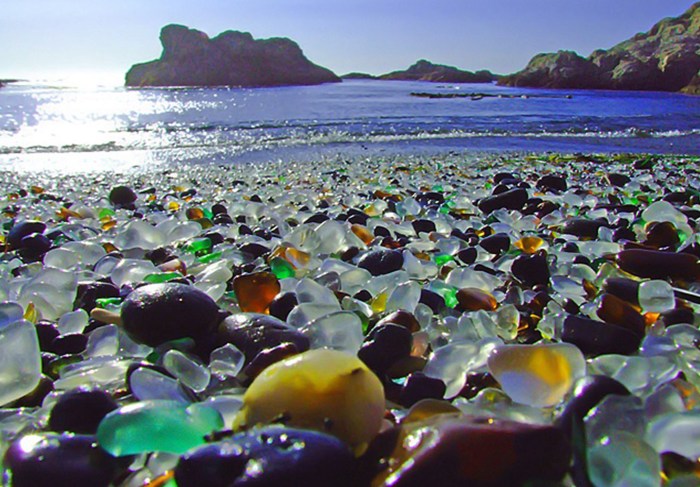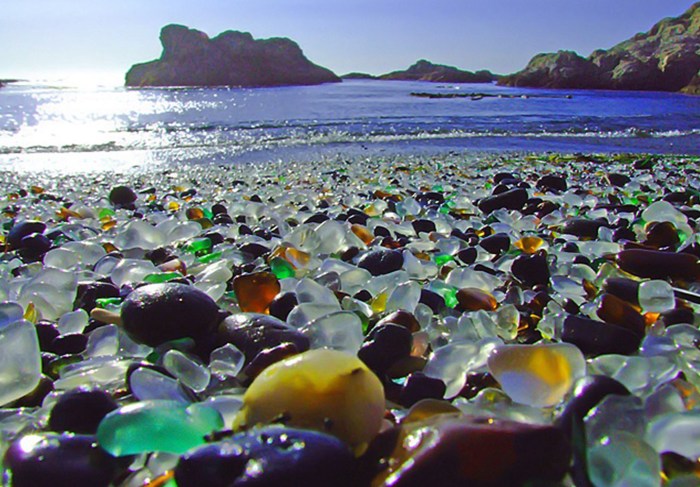Black beach glass, a captivating natural treasure, holds a unique allure that has captivated collectors and artists alike. Its enigmatic origins, intriguing historical significance, and diverse creative applications make it a subject worthy of exploration. This comprehensive guide delves into the captivating world of black beach glass, uncovering its fascinating characteristics, environmental impact, and the myriad ways it enriches our lives.
From its humble beginnings as discarded bottles to its transformation into a symbol of beauty and creativity, black beach glass has played a multifaceted role throughout history. Its presence in jewelry, art, and architecture speaks to its enduring appeal, while its scientific analysis provides insights into its composition and environmental impact.
As we delve deeper into the realm of black beach glass, we uncover its captivating allure and the diverse ways it continues to inspire.
Definition and Characteristics of Black Beach Glass
Black beach glass is a rare and unique type of sea glass that has been shaped and polished by the relentless waves and sand of the ocean. Its distinctive color and texture set it apart from other types of beach glass, making it a prized find for collectors and beachcombers alike.
Black beach glass is formed when dark-colored glass, such as black obsidian or dark green bottle glass, is tumbled in the ocean for extended periods. Over time, the sharp edges of the glass are smoothed, and the surface becomes frosted and opaque.
The resulting piece of black beach glass is typically smooth and rounded, with a matte finish that gives it a distinctive appearance.
Color and Texture
The color of black beach glass can range from deep black to a lighter shade of charcoal gray. The intensity of the color depends on the type of glass used and the length of time it has spent in the ocean.
The texture of black beach glass is typically smooth and matte, with a slightly pitted surface. This texture is caused by the erosion of the glass by the sand and water, which creates tiny pits and crevices in the surface.
Shape
Black beach glass can be found in a variety of shapes, including round, oval, and triangular. The shape of the glass is determined by the original shape of the glass object and the way it has been tumbled in the ocean.
Round pieces of black beach glass are the most common, as they are more easily tumbled and polished by the waves.
Sources
Black beach glass can be found on beaches all over the world, but it is most commonly found on beaches near areas where there is a lot of volcanic activity. This is because volcanic glass, such as obsidian, is a common source of black beach glass.
Other sources of black beach glass include dark green bottle glass and black ceramic tiles.
Historical Significance of Black Beach Glass
Black beach glass, a unique and enigmatic material, holds significant historical importance. Its distinctive color and alluring appearance have captivated humans for centuries, leading to its incorporation into various aspects of culture and art.
Jewelry and Adornment
Black beach glass has been used in jewelry making for centuries. Its smooth texture and deep color make it an attractive choice for beads, pendants, and earrings. In some cultures, black beach glass is believed to possess healing properties and is often incorporated into amulets and talismans.
Art and Decoration, Black beach glass
Black beach glass has also found its way into the world of art. Artists have used it to create mosaics, sculptures, and other decorative pieces. Its unique texture and color add a touch of intrigue and elegance to any artwork.
Architecture and Construction
In certain regions, black beach glass has been incorporated into architectural designs. Its durability and aesthetic appeal have made it a popular choice for use in flooring, countertops, and other decorative elements. Some buildings, particularly in coastal areas, feature black beach glass as a unique and eye-catching design element.
Cultural Significance
The cultural significance of black beach glass varies depending on the region and time period. In some cultures, it is associated with good luck and prosperity. In others, it is believed to have protective or healing powers. Black beach glass has also been used in religious ceremonies and rituals in some parts of the world.
Legends and Myths
Black beach glass has inspired numerous legends and myths over the centuries. One common belief is that it is formed from the tears of mermaids or other mythical creatures. Another legend suggests that black beach glass brings good luck to those who find it on the shore.
Environmental Impact of Black Beach Glass
Black beach glass pollution poses significant environmental concerns. Due to its small size and abundance, it can accumulate in marine ecosystems, harming marine life and disrupting natural habitats.
Black beach glass, often mistaken for gemstones, is a result of human waste disposal in the ocean. While enjoying the pokemon go routes london , beachcombers may find these smooth and colorful pieces, a reminder of the impact of littering.
Despite their origin, black beach glass remains a beautiful and unique collectible.
Ingestion of black beach glass by marine organisms can lead to physical damage, such as gastrointestinal blockages and lacerations. It can also release toxic chemicals, such as lead and cadmium, into the environment, posing health risks to both wildlife and humans.
Responsible Collection and Disposal
To mitigate the environmental impact of black beach glass, responsible collection and disposal practices are essential. Here are some recommendations:
- Avoid collecting large quantities of black beach glass, as this can deplete natural resources and disturb marine ecosystems.
- Handle black beach glass carefully to prevent breakage and the release of toxic chemicals.
- Dispose of black beach glass properly by recycling it or placing it in designated waste containers.
Collecting and Preserving Black Beach Glass
Discovering and collecting black beach glass can be a rewarding and enjoyable activity. However, it’s crucial to approach this pursuit responsibly to preserve the beauty of these natural treasures and respect the environment. This section will guide you through the best practices for finding, collecting, and preserving black beach glass.
Where and How to Find Black Beach Glass
Black beach glass is typically found on beaches near volcanic areas. The volcanic activity produces the dark minerals that give the glass its distinctive color. Some of the best places to find black beach glass include:
- Hawaii
- Iceland
- Alaska
- Oregon
- California
To find black beach glass, look for areas where the waves have tumbled the glass for an extended period. These areas are often found near jetties, piers, or other structures that create currents and waves. It’s also helpful to visit the beach after a storm, as the waves are more likely to have churned up the sand and exposed buried glass.
Proper Techniques for Collecting and Preserving Black Beach Glass
Once you’ve found black beach glass, it’s important to collect and preserve it properly to maintain its value and beauty. Here are some tips:
- Handle the glass with care to avoid breaking it.
- Rinse the glass with fresh water to remove any salt or sand.
- Dry the glass thoroughly with a soft cloth.
- Store the glass in a cool, dry place away from direct sunlight.
By following these tips, you can ensure that your black beach glass will remain a beautiful and cherished keepsake for years to come.
Respecting the Environment and Local Regulations
It’s essential to respect the environment when collecting black beach glass. Do not remove any glass from protected areas or beaches where collecting is prohibited. Additionally, be mindful of the wildlife and plants in the area and avoid disturbing them.
Before collecting black beach glass, it’s also important to check for any local regulations that may apply. Some areas may have restrictions on the amount of glass that can be collected or the methods used to collect it. By following local regulations, you can help preserve the beach environment for future generations.
Creative Uses of Black Beach Glass
Black beach glass, with its captivating allure and unique beauty, has inspired a myriad of creative endeavors. From exquisite jewelry to stunning home décor, this enigmatic material lends itself to a vast array of artistic expressions. This section will delve into the imaginative uses of black beach glass, showcasing its versatility and inspiring crafters and enthusiasts alike.
In the realm of jewelry, black beach glass takes center stage in necklaces, earrings, bracelets, and pendants. Its smooth, rounded edges and lustrous surface create eye-catching pieces that complement any style. Whether set in silver, gold, or copper, black beach glass adds a touch of coastal charm and elegance to any outfit.
Jewelry
- Black beach glass earrings, crafted with delicate wirework, exude a timeless allure.
- Pendant necklaces featuring a single piece of black beach glass, suspended on a leather cord, offer a minimalist yet sophisticated statement.
- Multi-strand bracelets adorned with black beach glass beads add a touch of bohemian flair to any ensemble.
Beyond jewelry, black beach glass finds its way into various crafts, transforming ordinary objects into works of art. From picture frames to decorative vases, this unique material adds a touch of coastal charm to any space.
Home Décor
- Black beach glass mosaic tiles create stunning backsplashes, tabletops, and accent walls, bringing the beauty of the ocean into the home.
- Wind chimes made from black beach glass emit a gentle, melodious sound, evoking memories of seaside strolls.
- Candle holders adorned with black beach glass cast a warm, inviting glow, creating a cozy and serene ambiance.
Innovative techniques and design ideas continue to emerge, pushing the boundaries of black beach glass artistry. From intricate wire wrapping to fused glass creations, crafters are constantly finding new ways to showcase the beauty of this unique material. With its versatility and timeless appeal, black beach glass remains a source of inspiration for creative minds.
Scientific Analysis of Black Beach Glass
Scientific methods play a crucial role in understanding the composition, properties, and environmental impact of black beach glass. These methods involve a combination of analytical techniques, field studies, and laboratory experiments.
Analytical Techniques
- X-ray fluorescence (XRF): This technique measures the elemental composition of black beach glass by bombarding it with X-rays and analyzing the emitted fluorescent radiation.
- Scanning electron microscopy (SEM): SEM provides detailed images of the surface and cross-section of black beach glass, revealing its microstructure and chemical composition.
- Electron probe microanalysis (EPMA): EPMA combines SEM with XRF to provide precise elemental analysis at specific points within the glass.
Field Studies
Field studies involve collecting and examining black beach glass from different locations to determine its distribution, abundance, and characteristics. These studies help identify the sources of the glass and the processes that have shaped its properties.
Laboratory Experiments
Laboratory experiments simulate the conditions under which black beach glass is formed to better understand its origins and properties. Experiments may involve melting glass under controlled temperatures and pressures or exposing glass to environmental factors such as weathering and erosion.
Findings of Studies
Studies on black beach glass have revealed:
- Origins:Most black beach glass originates from discarded bottles and other glass objects that have been tumbled and weathered in the ocean.
- Formation:Black beach glass forms when iron impurities in the glass oxidize and absorb light, giving it its distinctive dark color.
- Environmental impact:Black beach glass can have both positive and negative environmental impacts. It can provide a habitat for marine organisms but can also accumulate pollutants.
Areas for Further Research
Despite the progress made in understanding black beach glass, several areas require further research:
- Source identification:Identifying the specific sources of black beach glass can help trace its origins and assess its environmental impact.
- Formation mechanisms:Understanding the precise mechanisms that lead to the formation of black beach glass can provide insights into the behavior of glass in marine environments.
- Ecological role:Investigating the ecological role of black beach glass in marine ecosystems can shed light on its potential benefits and risks.
Black Beach Glass in Literature and Art
Black beach glass has captured the imagination of writers and artists for centuries, inspiring works that explore its beauty, symbolism, and cultural significance.
Literary Depictions
In literature, black beach glass often symbolizes mystery, loss, and the passage of time. Emily Dickinson’s poem “After the Rain” features a “jet of glass” that represents the speaker’s lost love. In “The Glass Castle,” Jeannette Walls uses black beach glass to evoke the beauty and fragility of her childhood home.
Artistic Representations
In art, black beach glass has been used to create stunning sculptures, paintings, and jewelry. Glass artist Dale Chihuly has incorporated black beach glass into his famous blown glass installations, capturing its unique texture and color. Painter Edward Hopper depicted black beach glass in his iconic painting “Cape Cod Evening,” where it symbolizes the solitude and melancholy of the coastal landscape.
Notable Authors and Artists
Notable authors and artists who have featured black beach glass in their creations include:
-
-*Authors
Emily Dickinson, Jeannette Walls, Henry David Thoreau
-*Artists
Dale Chihuly, Edward Hopper, Georgia O’Keeffe
Conservation and Sustainability of Black Beach Glass

Preserving black beach glass is crucial for environmental sustainability and the appreciation of its unique aesthetic and historical value. Conservation efforts focus on minimizing human impact and promoting sustainable practices related to black beach glass collection and disposal.
Challenges include preventing over-collection, reducing pollution, and educating the public about the importance of conservation. Opportunities lie in implementing responsible collection guidelines, encouraging proper disposal, and raising awareness through educational programs.
Individual Contributions
- Collect black beach glass sustainably, avoiding over-collection and disturbing natural habitats.
- Dispose of glass responsibly, preventing it from becoming litter or polluting waterways.
- Educate others about the value and importance of conserving black beach glass.
Organizational Initiatives
- Establish guidelines for sustainable black beach glass collection and disposal.
- Implement educational programs to raise awareness about the conservation of black beach glass.
- Collaborate with beach cleanup organizations to remove litter and prevent pollution.
Wrap-Up

Black beach glass, a testament to the transformative power of nature, stands as a symbol of resilience and creativity. Its journey from discarded waste to cherished treasure underscores the importance of conservation and sustainable practices. As we continue to explore the multifaceted nature of black beach glass, we deepen our appreciation for its beauty, historical significance, and the endless possibilities it offers for artistic expression.
May this guide serve as a catalyst for further exploration and a reminder of the wonders that lie hidden within the natural world.
Q&A
What is the origin of black beach glass?
Black beach glass originates from discarded bottles and other glass objects that have been tumbled and weathered by the ocean’s waves and sand, resulting in their smooth, frosted appearance and distinctive color.
Is black beach glass valuable?
The value of black beach glass varies depending on its rarity, size, and condition. Rare colors and larger pieces tend to be more valuable, particularly among collectors and jewelry makers.
How can I identify black beach glass?
Black beach glass is typically opaque and has a smooth, frosted surface. It can be distinguished from other types of glass by its unique color and the absence of sharp edges or bubbles.



